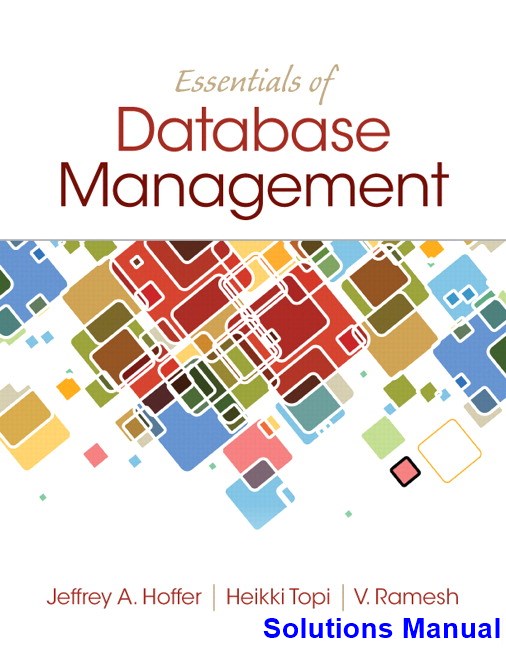This is completed downloadable of Essentials of Database Management 1st Edition Hoffer Solutions Manual

Product Details:
- ISBN-10 : 0133405680
- ISBN-13 : 978-0133405682
- Author:
Readers who want an up-to-date overview of database development and management.
Focusing on the topics that leading database practitioners say are most important, Essentials of Database Management presents a concise overview designed to ensure practical success for database professionals.
Built upon the strong foundation of Modern Database Management, currently in its eleventh edition, the new Essentials of Database Management is ideal for a less-detailed approach. Like its comprehensive counterpart, it guides readers into the future by presenting research that could reveal the “next big thing” in database management. And it features up-to-date coverage in the areas undergoing rapid change due to improved managerial practices, database design tools and methodologies, and database technology.
Table of Content:
- Part I: The Context of Database Management
- Part II : Database Analysis
- Part III : Database Design
- Part IV : Implementation
- Pedagogy
- Supplements: www.pearsonhighered.com/Hoffer
- Part I The Context of Database Management
- Chapter 1 The Database Environment and Development Process
- Learning Objectives
- Basic Concepts and Definitions
- Data
- Data Versus Information
- Metadata
- Traditional File Processing Systems
- Disadvantages of File Processing Systems
- Program-Data Dependence
- Duplication of Data
- Limited Data Sharing
- Lengthy Development Times
- Excessive Program Maintenance
- The Database Approach
- Data Models
- Entities
- Relationships
- Relational Databases
- Database Management Systems
- Advantages of the Database Approach
- Program-Data Independence
- Planned Data Redundancy
- Improved Data Consistency
- Improved Data Sharing
- Increased Productivity of Application Development
- Enforcement of Standards
- Improved Data Quality
- Improved Data Accessibility and Responsiveness
- Reduced Program Maintenance
- Improved Decision Support
- Cautions About Database Benefits
- Costs and Risks of the Database Approach
- New, Specialized Personnel
- Installation and Management Cost and Complexity
- Conversion Costs
- Need for Explicit Backup and Recovery
- Organizational Conflict
- Components of the Database Environment
- The Database Development Process
- Systems Development Life Cycle
- Planning—Enterprise Modeling
- Planning—Conceptual Data Modeling
- Analysis—Conceptual Data Modeling
- Design—Logical Database Design
- Design—Physical Database Design and Definition
- Implementation—Database Implementation
- Maintenance—Database Maintenance
- Alternative Information Systems (IS) Development Approaches
- Three-Schema Architecture for Database Development
- Evolution of Database Systems
- The Range of Database Applications
- Personal Databases
- Two-Tier Client/Server Databases
- Multitier Client/Server Databases
- Enterprise Applications
- Developing A Database Application for Pine Valley Furniture Company
- Database Evolution at Pine Valley Furniture Company
- Project Planning
- Analyzing Database Requirements
- Designing the Database
- Using the Database
- Administering the Database
- Future of Databases at Pine Valley
- Summary
- Chapter Review
- Key Terms
- Review Questions
- Problems and Exercises
- References
- Further Reading
- Web Resources
- Part II Database Analysis
- Chapter 2 Modeling Data in the Organization
- Learning Objectives
- Introduction
- The E-R Model: An Overview
- Sample E-R Diagram
- E-R Model Notation
- Modeling the Rules of the Organization
- Data Names and Definitions
- Data Names
- Data Definitions
- Good Data Definitions
- Modeling Entities and Attributes
- Entities
- Entity Type Versus Entity Instance
- Entity Type Versus System Input, Output, or User
- Strong Versus Weak Entity Types
- Naming and Defining Entity Types
- Attributes
- Required Versus Optional Attributes
- Simple Versus Composite Attributes
- Single-Valued Versus Multivalued Attributes
- Stored Versus Derived Attributes
- Identifier Attribute
- Naming and Defining Attributes
- Modeling Relationships
- Basic Concepts and Definitions in Relationships
- Attributes on Relationships
- Associative Entities
- Degree of a Relationship
- Unary Relationship
- Binary Relationship
- Ternary Relationship
- Attributes or Entity?
- Cardinality Constraints
- Minimum Cardinality
- Maximum Cardinality
- Some Examples of Relationships and Their Cardinalities
- A Ternary Relationship
- Modeling Time-Dependent Data
- Modeling Multiple Relationships Between Entity Types
- Naming and Defining Relationships
- E-R Modeling Example: Pine Valley Furniture Company
- Database Processing at Pine Valley Furniture
- Showing Product Information
- Showing Product Line Information
- Showing Customer Order Status
- Summary
- Chapter Review
- Key Terms
- Review Questions
- Problems and Exercises
- References
- Further Reading
- Web Resources
- Chapter 3 The Enhanced E-R Model
- Learning Objectives
- Introduction
- Representing Supertypes and Subtypes
- Basic Concepts and Notation
- An Example of a Supertype/Subtype Relationship
- Attribute Inheritance
- When to Use Supertype/Subtype Relationships
- Representing Specialization and Generalization
- Generalization
- Specialization
- Combining Specialization and Generalization
- Specifying Constraints in Supertype/Subtype Relationships
- Specifying Completeness Constraints
- Total Specialization Rule
- Partial Specialization Rule
- Specifying Disjointness Constraints
- Disjoint Rule
- Overlap Rule
- Defining Subtype Discriminators
- Disjoint Subtypes
- Overlapping Subtypes
- Defining Supertype/Subtype Hierarchies
- An Example of a Supertype/Subtype Hierarchy
- Summary of Supertype/Subtype Hierarchies
- EER Modeling Example: Pine Valley Furniture Company
- Packaged Data Models
- A Revised Data Modeling Process with Packaged Data Models
- Summary of Prepackaged Data Models
- Summary
- Chapter Review
- Key Terms
- Review Questions
- Problems and Exercises
- References
- Further Reading
- Web Resources
- Part III Database Design
- Chapter 4 Logical Database Design and the Relational Model
- Learning Objectives
- Introduction
- The Relational Data Model
- Basic Definitions
- Relational Data Structure
- Relational Keys
- Properties of Relations
- Removing Multivalued Attributes from Tables
- Sample Database
- Integrity Constraints
- Domain Constraints
- Entity Integrity
- Referential Integrity
- Creating Relational Tables
- Well-Structured Relations
- Transforming EER Diagrams Into Relations
- Step 1: Map Regular Entities
- Composite Attributes
- Multivalued Attributes
- Step 2: Map Weak Entities
- When to Create a Surrogate Key
- Step 3: Map Binary Relationships
- Map Binary One-to-Many Relationships
- Map Binary Many-to-Many Relationships
- Map Binary One-to-One Relationships
- Step 4: Map Associative Entities
- Identifier Not Assigned
- Identifier Assigned
- Step 5: Map Unary Relationships
- Unary One-to-Many Relationships
- Unary Many-to-Many Relationships
- Step 6: Map Ternary (and n-ary) Relationships
- Step 7: Map Supertype/Subtype Relationships
- Summary of EER-to-Relational Transformations
- Introduction to Normalization
- Steps in Normalization
- Functional Dependencies and Keys
- Determinants
- Candidate Keys
- Normalization Example: Pine Valley Furniture Company
- Step 0: Represent the View in Tabular Form
- Step 1: Convert to First Normal Form
- Remove Repeating Groups
- Select the Primary Key
- Anomalies in 1NF
- Step 2: Convert to Second Normal Form
- Step 3: Convert to Third Normal Form
- Removing Transitive Dependencies
- Determinants and Normalization
- Merging Relations
- An Example
- View Integration Problems
- Synonyms
- Homonyms
- Transitive Dependencies
- Supertype/Subtype Relationships
- Summary
- Chapter Review Key Terms
- Review Questions
- Problems and Exercises
- References
- Further Reading
- Web Resources
- Chapter 5 Physical Database Design and Performance
- Learning Objectives
- Introduction
- The Physical Database Design Process
- Physical Database Design as a Basis for Regulatory Compliance
- Designing Fields
- Choosing Data Types
- Coding Techniques
- Controlling Data Integrity
- Handling Missing Data
- Denormalizing Data
- Denormalization
- Opportunities for and Types of Denormalization
- Denormalize With Caution
- Designing Physical Database Files
- File Organizations
- Sequential File Organizations
- Indexed File Organizations
- Hashed File Organizations
- Designing Controls for Files
- Using and Selecting Indexes
- Creating a Unique Key Index
- Creating a Secondary (Nonunique) Key Index
- When to Use Indexes
- Designing a Database for Optimal Query Performance
- Summary
- Chapter Review Key Terms
- Review Questions
- Problems and Exercises
- References
- Further Reading
- Web Resources
- Part IV Implementation
- Chapter 6 Introduction to SQL
- Learning Objectives
- Introduction
- Origins of the Sql Standard
- The Sql Environment
- Defining a Database In SQL
- Generating SQL Database Definitions
- Creating Tables
- Creating Data Integrity Controls
- Changing Table Definitions
- Removing Tables
- Inserting, Updating, and Deleting Data
- Deleting Database Contents
- Updating Database Contents
- Internal Schema Definition in RDBMSs
- Creating Indexes
- Processing Single Tables
- Clauses of the SELECT Statement
- Using Expressions
- Using Functions
- Using Wildcards
- Using Comparison Operators
- Using Null Values
- Using Boolean Operators
- Using Ranges for Qualification
- Using Distinct Values
- Using IN and NOT IN with Lists
- Sorting Results: The ORDER BY Clause
- Categorizing Results: The GROUP BY Clause
- Qualifying Results by Categories: The HAVING Clause
- Using and Defining Views
- Summary
- Review Questions
- Problems and Exercises
- References
- Further Reading
- Web Resources
- Chapter 7 Advanced SQL
- Learning Objectives
- Introduction
- Processing Multiple Tables
- Equi-join
- Natural Join
- Outer Join
- Sample Join Involving Four Tables
- Self-Join
- Subqueries
- Correlated Subqueries
- Using Derived Tables
- Combining Queries
- Tips for Developing Queries
- Guidelines for Better Query Design
- Ensuring Transaction Integrity
- Data Dictionary Facilities
- Triggers and Routines
- Triggers
- Routines
- Example Routine in Oracle’s PL/SQL
- Embedded SQL and Dynamic SQL
- Summary
- Chapter Review Key Terms
- Review Questions
- Problems and Exercises Problems and Exercises
- References
- Further Reading
- Web Resources
- Chapter 8 Database Application Development
- Learning Objectives
- Introduction
- Client/Server Architectures
- Databases in a Two-Tier Architecture
- A VB.NET Example
- A Java Example
- Three-Tier Architectures
- Web Application Components
- Databases in Three-Tier Applications
- A JSP Web Application
- An ASP.NET Example
- Key Considerations in Three-Tier Applications
- Stored Procedures
- Transactions
- Database Connections
- Key Benefits of Three-Tier Applications
- Cloud Computing and Three-Tier Applications
- Extensible Markup Language (XML)
- Storing XML Documents
- Retrieving XML Documents
- Displaying XML Data
- XML and Web Services
- Summary
- Chapter Review Key Terms
- Review Questions
- Problems and Exercises
- References
- Further Reading
- Web Resources
- Chapter 9 Data Warehousing
- Learning Objectives
- Introduction
- Basic Concepts of Data Warehousing
- A Brief History of Data Warehousing
- The Need for Data Warehousing
- Need for a Company-Wide View
- Need to Separate Operational and Informational Systems
- Data Warehouse Architectures
- Independent Data Mart Data Warehousing Environment
- Dependent Data Mart and Operational Data Store Architecture: A Three-Level Approach
- Logical Data Mart and Real-Time Data Warehouse Architecture
- Three-Layer Data Architecture
- Role of the Enterprise Data Model
- Role of Metadata
- Some Characteristics of Data Warehouse Data
- Status Versus Event Data
- Transient Versus Periodic Data
- An Example of Transient and Periodic Data
- Transient Data
- Periodic Data
- Other Data Warehouse Changes
- The Derived Data Layer
- Characteristics of Derived Data
- The Star Schema
- Fact Tables and Dimension Tables
- Example Star Schema
- Surrogate Key
- Grain of the Fact Table
- Duration of the Database
- Size of the Fact Table
- Modeling Date and Time
- Slowly Changing Dimensions
- Determining Dimensions and Facts
- Big Data and Columnar Databases
- If You Knew SQL Like I NoSQL
- The User Interface
- Role of Metadata
- SQL OLAP Querying
- Online Analytical Processing (OLAP) Tools
- Slicing a Cube
- Drill-Down
- Summarizing More Than Three Dimensions
- Data Visualization
- Business Performance Management and Dashboards
- Data-Mining Tools
- Data-Mining Techniques
- Data-Mining Applications
- DATA GOVERNANCE AND DATA QUALITY
- Data Governance
- Managing Data Quality
- Characteristics of Quality Data
- Summary
- Chapter Review Key Terms
- Review Questions
- Problems and Exercises
- References
- Further Reading
- Web Resources
- Glossary of Acronyms
- Glossary of Terms
- Index
- A
- B
- C
- D
- E
- F
- G
- H
- I
- J
- K
- L
- M
- N
- O
- P
- Q
- R
- S
- T
- U
- V
- W
- X
- Y





